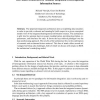Free Online Productivity Tools
i2Speak
i2Symbol
i2OCR
iTex2Img
iWeb2Print
iWeb2Shot
i2Type
iPdf2Split
iPdf2Merge
i2Bopomofo
i2Arabic
i2Style
i2Image
i2PDF
iLatex2Rtf
Sci2ools
WIIW
2001
2001
RDF-Based Architecture for Semantic Integration of Heterogeneous Information Sources
The proposed integration architecture aims at exploiting data semantics in order to provide a coherent and meaningful (with respect to a given conceptual model) view of the integrated heterogeneous information sources. The architecture is split into five separate layers to assure modularization, providing description, requirements, and interfaces for each. It favors the lazy retrieval paradigm over the data warehousing approach. The novelty of the architecture lies in the combination of semantic and on-demand driven retrieval. This line of attack offers several advantages but brings also challenges, both of which we discuss with respect to RDF, the architecture's underlying model.
| Added | 31 Oct 2010 |
| Updated | 31 Oct 2010 |
| Type | Conference |
| Year | 2001 |
| Where | WIIW |
| Authors | Richard Vdovjak, Geert-Jan Houben |
Comments (0)

